This CPD, sponsored by Viega, looks at the issues around ensuring that piping systems carrying drinking water meet current regulations, alongside the design, manufacture, installation and risk of contamination for pipework
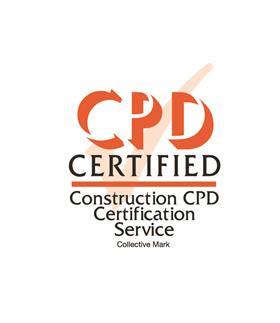
CPD CREDITS: 60 MINUTES
DEADLINE: 10 MAY 2019
For more information about Assemble Media Group’s CPD distance-learning programme, click here
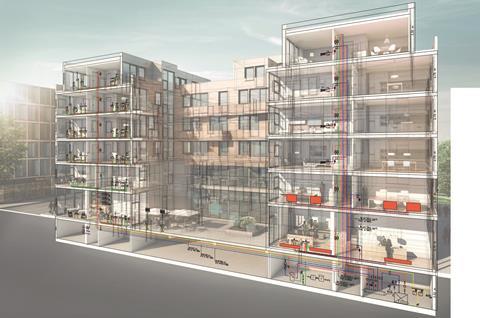

Introduction
Ensuring that a building has a supply of water suitable for drinking and food preparation is vital. While much of the safety of water depends on the drinking water quality that suppliers provide, piping systems need to be manufactured, tested, installed and maintained to the highest possible standards to ensure ultimate safety for individual buildings.
Therefore, it is necessary that all pipework installed in buildings complies with current UK and EU regulations that provide minimum standards for drinking water quality. The current standards are the highest in the world, and as a vanguard of best practice, the UK is very unlikely to make any changes to regulation that would lower water quality as a result of leaving the EU. Current EN standards are aligned with previous BS standards.
This CPD will examine the issues facing those charged with ensuring that the resulting pipework meets these requirements. It will also look at the design, manufacture and installation of pipework, sources of contamination, testing regimes, repairs, building types and usage considerations.
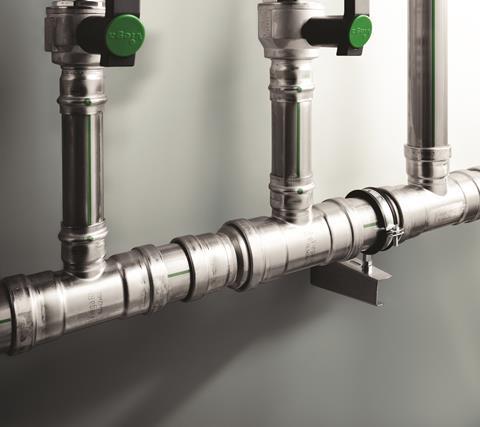
Standards and water safety
European standards, from which the UK’s regulations are currently derived, are closely linked to regularly updated guidance from the World Health Organization (WHO). The WHO document Guidelines for Drinking-water Quality, now in its fourth edition, stresses there should be a base standard for potable water. It provides acceptable limits for microbial, chemical and radiological elements that would impact human health and sets out “acceptability aspects” such as taste, odour and appearance that may affect consumer confidence in the quality of the water.
The WHO defines the roles and responsibilities of those involved in the supply of drinking water, from storage and distribution through to the use and consumption of water in both private and public buildings. It also gives a detailed framework for the correct management of the water at each stage of the supply chain, all the way to the consumer.
The WHO guidance states that “significant adverse health effects have been associated with inadequate plumbing systems within public and private buildings, arising from poor design, incorrect installation, alterations and inadequate maintenance”, so the quality of the pipework between the mains supply and the point of consumption is extremely important.
The 1998 European Drinking Water Directive, which sets the minimum standard for water for human use across all EU countries, requires that the quality level stated must be achieved at all hot and cold water delivery points. In addition, the UK water system and pipework designs must comply with the minimum requirements of British Standards, Building Regulations (Building Standards in Scotland), the Water Supply (Water Fittings) Regulations 1999, and the Water Supply (Water Quality) Regulations 2000.
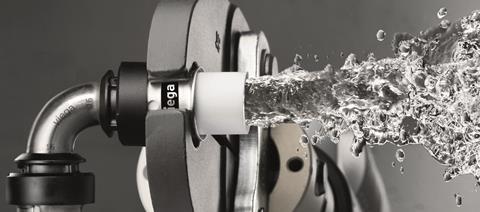
Sources of contamination
The main aim of the UK water regulations is to prevent contamination, which can occur in a number of ways, including:
- Ingress into the systems, for instance bird droppings in uncovered storage cisterns or bacteria introduced during installation, repair or addition to the system
- Use of unsuitable materials during construction, for example, lead-based solder in copper pipe joints
- Cross-connection with non-potable water, such as recycled greywater or rainwater
- Backflow of contaminated fluids drawn back into drinking-water systems from other pipework or outlets. This can occur as a result of high pressure within equipment attached to the pipework or, conversely, inadequate pressure in the system as a whole.
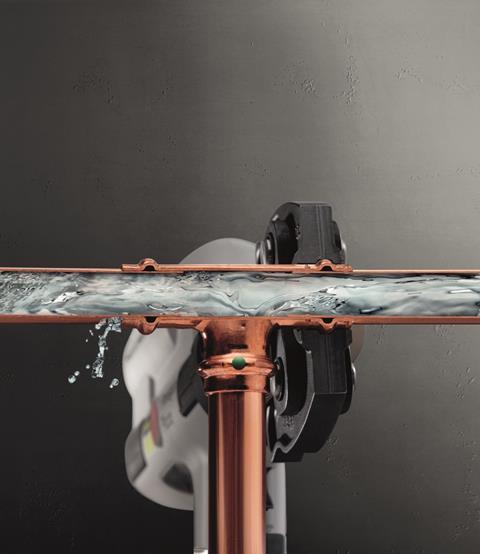
Preventing contamination
All components of a drinking-water installation must be supplied to the building site in a hygienic state. This means that at each stage of the supply chain, steps must be taken to reduce the risk of contamination. Importantly, if the manufacture of pipework is not managed correctly, bacteria can be introduced during the making of components. Any water left in the product after wet leakage tests will encourage the growth of microorganisms during potentially long storage times, particularly if the materials are kept in warm conditions. For this reason, dry leakage tests – which use air to assess a pipe for leaks, rather than liquid – are preferred to prevent the microbial risk developing, since bacteria can be difficult to remove once they are established in the system.
For example, if a clinic installed a new pressure-booster system that was later found to have been contaminated during a wet leakage test in the factory of manufacture, then the drinking-water installation would need to be continually disinfected with chemicals due to the presence of Pseudomonas aeruginosa bacteria – which is often associated with hospital-acquired infections.
Another consideration is ensuring that pipes and fittings are stored while a building is being constructed in a way that excludes the risk of penetration by dirt and contaminated water. As construction phases often last for long periods of time, there is a great risk of contamination occurring in the components even before the system is commissioned. Pipes can be supplied fitted with end stoppers so that hygienic transportation can be guaranteed. Similarly, protective caps to seal riser pipes during assembly will reduce the risk of contamination from dust and chemicals.
Although such contamination is normally not considered critical in terms of microbiology, it may require a significant flushing effort to clean such deposits from the network of pipes before operation. The connection method and materials used is also a potential source of contamination if not selected correctly. For example, using lead-based solders on copper pipe can pollute the potable water.

Testing and commissioning
To reduce the risk of contamination after testing, it is recommended that dry leakage tests are employed to check the system following installation, using dry, oil-free air. For systems where higher levels of hygiene must be maintained – for example in hospitals – inert gases can be used. This is especially important on large-scale projects where there may be an extended period of time between completion of the pipework installation and the handover of the building.
To dry test a system, the pipework is pressurised with air up to 110 millibar for a defined time. The length of the test depends on the volume of the pipework. For 100 litres of capacity, the test should last at least 30 minutes and be increased by 10 minutes for every additional 100 litres. If there is a leak, a recordable drop in pressure will occur across the system.
Leak testing with water should only be considered if the system will be made operational immediately afterwards – for example in individual residential properties. Furthermore, any flushing of the installation required should take place as close to the property’s handover as possible. This will prevent microbial contamination that would compromise the quality of the drinking water.

Repair
Another potential source of contamination exists during any repair works or additions to existing systems. The risks to drinking water quality should be considered just as carefully when carrying out work on older systems or addressing operational breakdowns as when working on new installations. For example, those doing maintenance activities should be careful to ensure they wash their hands thoroughly after working in potentially contaminated areas before continuing work on potable water pipework.
Here too, it is vital to ensure that any new components are kept contaminant-free from the point of manufacture through to commissioning. Some fittings manufacturers supply their products in individual packaging and it is very important that any fitting should only be removed from such packaging directly before use.
Pipe material
The choice of the material for an installation is often dependent on technical and economic considerations. Materials and products must meet requirements determined by local needs and the properties of the water. Factors that should be considered when choosing the material for the piping include:
- Characteristics of the water supply – the air, carbon dioxide and mineral content as well as the alkalinity or acidity
- The cost of installing suitable materials – including requirements for bracketing
- Ease of replacement
- Inside dimensions – the actual inside dimensions of pipes and fittings of different materials may differ despite the same nominal size
- Coefficient of friction of materials – the roughness or smoothness of the interior surface of the pipe.
Materials typically used for potable water supply pipework include copper, stainless steel and various plastics, including cross-linked polyethylene (PEX), thermoplastic (ABS), medium density polyethylene (MDPE) for barrier pipes, polybutylene and multilayer pipe. A particular material may be the preferred for different applications. Metal pipe may be chosen where fewer fixing points along the pipe length is beneficial, where space for pipework expansion is limited, or where improved resistance to fire is an advantage. In contrast, multilayer pipe may be chosen where flexibility is an advantage, such as installations in tight spaces. There can also be benefits to combining two systems – using copper or stainless steel for the underfloor and riser pipes and employing plastic or multilayer pipe for distribution pipes on the final pipework to outlets.
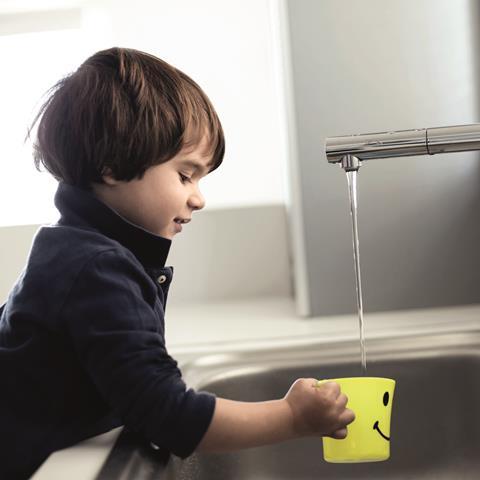
Designing systems to maintain flow
The correct sizing of pipework and reduction of friction within the system will ensure optimum system pressure and flow velocity. This will prevent unnecessary stagnation and backflow into the system occurring. The fittings, pipe and design of the system will all contribute to the friction in the pipework and reduce the flow.
However, oversized piping reduces the pressure that can be maintained. Not only will users of the building experience low water pressure but there is also increased risk of backflow from equipment on the system that creates a higher pressure. Many pipe and fittings manufacturers will provide tools to help designers and contractors calculate the correct sizing and pressure for the system.
Building type and usage
The predicted usage pattern of the building must be considered when designing a potable water system. While this cannot be fully calculated before the building is occupied, the intended use will provide indications.
For example, the use and occupancy of a school, college or university building will fluctuate considerably throughout the year from intensive activity during term time to being empty for weeks during school holidays. This means the system must have sufficient capacity for peak demand during break times but be able to address long interruptions during the holidays, when stagnation increases the risk of microbiological contamination of potable water.
The types of usage pattern for buildings are:
- Rarely interrupted – where systems are in constant use, for instance, residential buildings
- Interruption on a room or apartment basis – ie, hotels or serviced apartment blocks
- Interruption of use on a storey basis – for example, serviced offices with intermittently vacant floors
- Interruption in use on a building basis – educational establishments and hospitality venues, which may be fully unoccupied for weeks or months.

How to take this module
Assemble Media Group’s CPD distance-learning programme is open to anyone seeking to develop their knowledge and skills. Each module also offers members of professional institutions an opportunity to earn between 30 and 90 minutes of credits towards their annual CPD requirement.
This article is accredited by the CPD Certification Service. To earn CPD credits, read the article and then click the link below to complete your details and answer the questions. You will receive your results instantly, and if all the questions are correctly answered, you will be able to download your CPD certificate straight away.
CPD CREDITS: 60 MINUTES
DEADLINE: 10 MAY 2019
Privacy policy
Information you supply to Assemble Media Group Limited may be used for publication and also to provide you with information about our products or services in the form of direct marketing by email, telephone, fax or post. Information may also be made available to third parties. Assemble Media Group Limited may send updates about Building CPD and other relevant Assemble Media Group Limited products and services. By providing your email address you consent to being contact by email, telephone, fax or post by Assemble Media Group Limited or other third parties. If at any time you no longer wish to receive anything from Assemble Media Group Limited or to have your data made available to third parties, contact the Data Protection Coordinator at building@building.co.uk. View our full privacy policy her



























